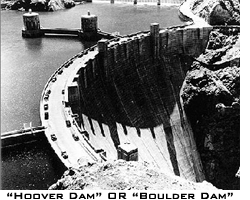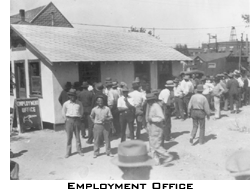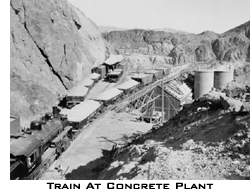Construction History of Hoover Dam
A Brief Overview of Hoover Dam Construction

Awarding of the Hoover Dam Contract. Six construction firms created a consortium call Six Company, Inc. to submit a competitive proposal to build Hoover Dam. As the lowest qualified bidder at $48,890,955, Six Company was awarded the contract. It was given incentive bonuses and would be fined for each day construction overran the assigned schedule. Thus began a furious pace of around the clock construction, which would result in completion of Hoover Dam almost two years ahead of schedule.

The Great Depression led to massive migration of the unemployed to Las Vegas in hopes of landing jobs building Hoover Dam. Men came from around the country, many bringing families and life’s possessions hoping for employment. Living conditions were difficult and became substantially much worse when construction began, creating the shantytown known as Ragtown. Read more about the Men, Women and Children of Hoover Dam where life became a living hell. Life was particularly difficult for the few blacks that were hired as token to government mandate.

The Colorado River had to be diverted before construction could begin. The riverbed had to be dredged clear of deep silt and sediment to expose a bedrock foundation for the building of Hoover Dam. It was a tedious process of digging four diversion tunnels through canyon walls that would divert river flow around the dam site to join the Colorado River farther downstream. Click here to read more about the Hoover Dam Diversion Tunnels.
Hoover Dam required over 3,250,000 cubic yards of concrete plus another million for the power plant, intake towers and other support structures. Two batch plants onsite were created to produce the concrete that was transported on railcars in large four and eight cubic yard buckets. An overhead cableway system lifted the buckets and lowered them to the forms. At peak production, one bucket was delivered about every 78 seconds. See more information and statistics on our Hoover Dam home web page.

The base of Hoover Dam alone required 230 individual gigantic blocks of concrete. Five-foot tall blocks of varying width, ranging from 25 square feet on the downstream face to 60 square feet on the upstream face. Columns were linked together like a giant Lego set with a system of alternating vertical and horizontal schemes.
It is interesting to note that it would have taken about 100 years for the concrete to cool and properly cure without engineering intervention. The chemical heat generated by concrete setting was dissipated by imbedding over 582 miles of one-inch steel pipe through the interconnecting concrete blocks that circulated ice water. Its own ammonia refrigeration plant that cooled the water was capable of creating a gigantic 1000 pound ice block every day.

The cooling pipes were subsequently back-filled with concrete to create added strength. As an arch-gravity dam, the massive water pressure of up to 45,000 pounds per square foot at the base of Hoover Dam, is held back by gravity. The arch-curved structure against the lake reservoir dissipates that pressure into the canyon walls equally on the Arizona and Nevada side.
It was the job of High Scalers to hang dangerously by rope above the canyon to blast and remove weakened and loose rocks from the face of the Black Canyon cliffs where the ends of Hoover Dam would join. Read more about these High Scalers that risked their lives not only performing their jobs, but also entertaining workers below with thrill-seeking and death-defying stunts along the cliff walls.
For detailed information, use the right-side navigation to access interesting insight into the building history of Hoover Dam.
Photos compliments of: Boulder City Museum
Related Hoover Dam Interest
Hoover Dam
Building Hoover Dam
Hoover Dam Diversion Tunnels
Hoover Dam High Scalers
Hoover Dam Historic Photos
Hoover Dam Map
Hoover Dam Men
Hoover Dam Pictures
Along The Colorado River
Colorado River Lakes
Lake Powell
Lake Mead
Lake Mohave
Lake Havasu















